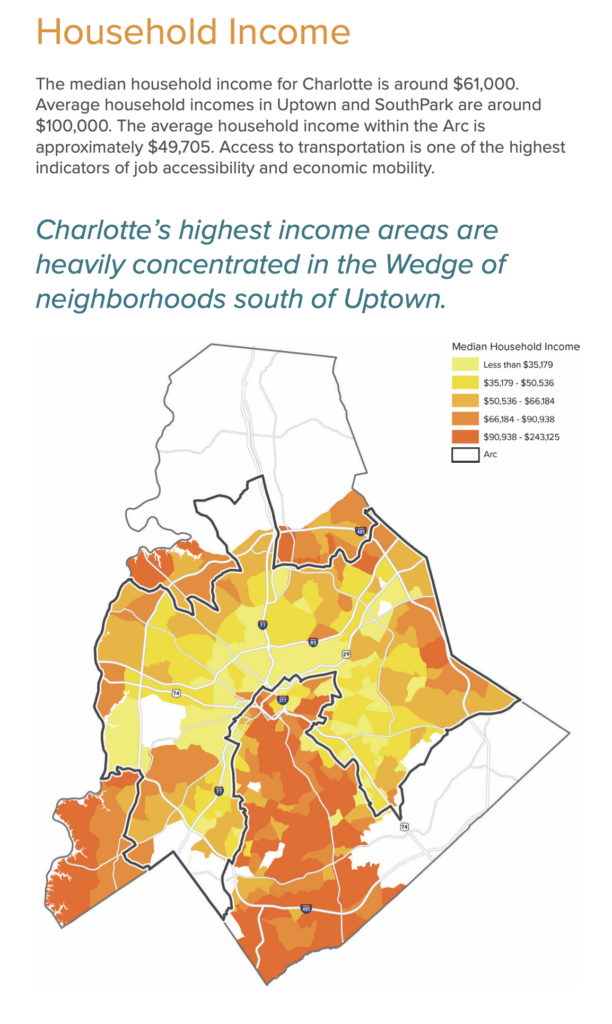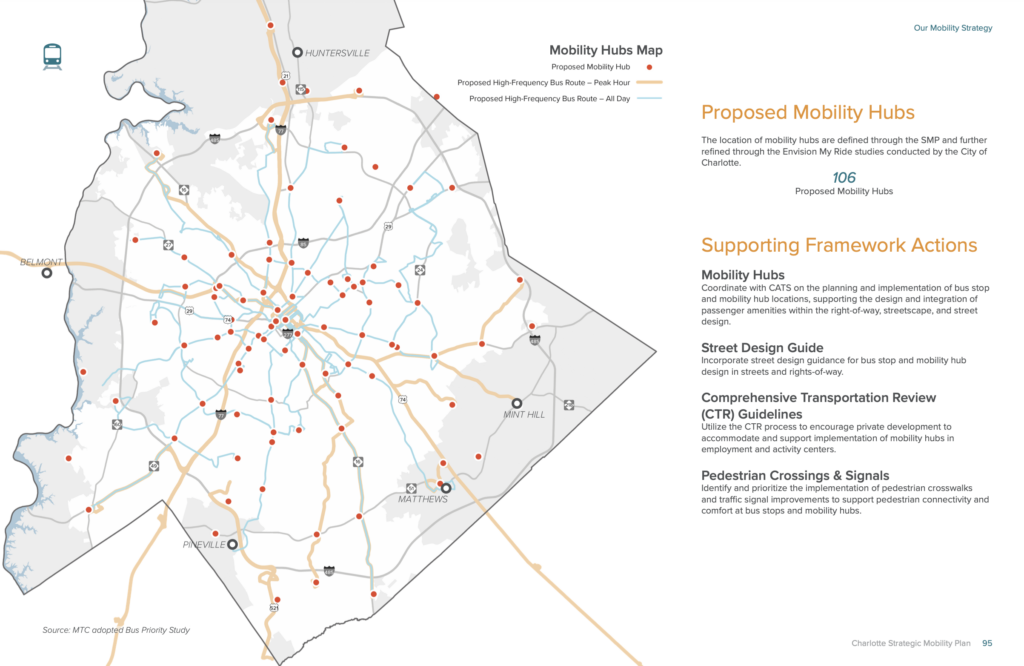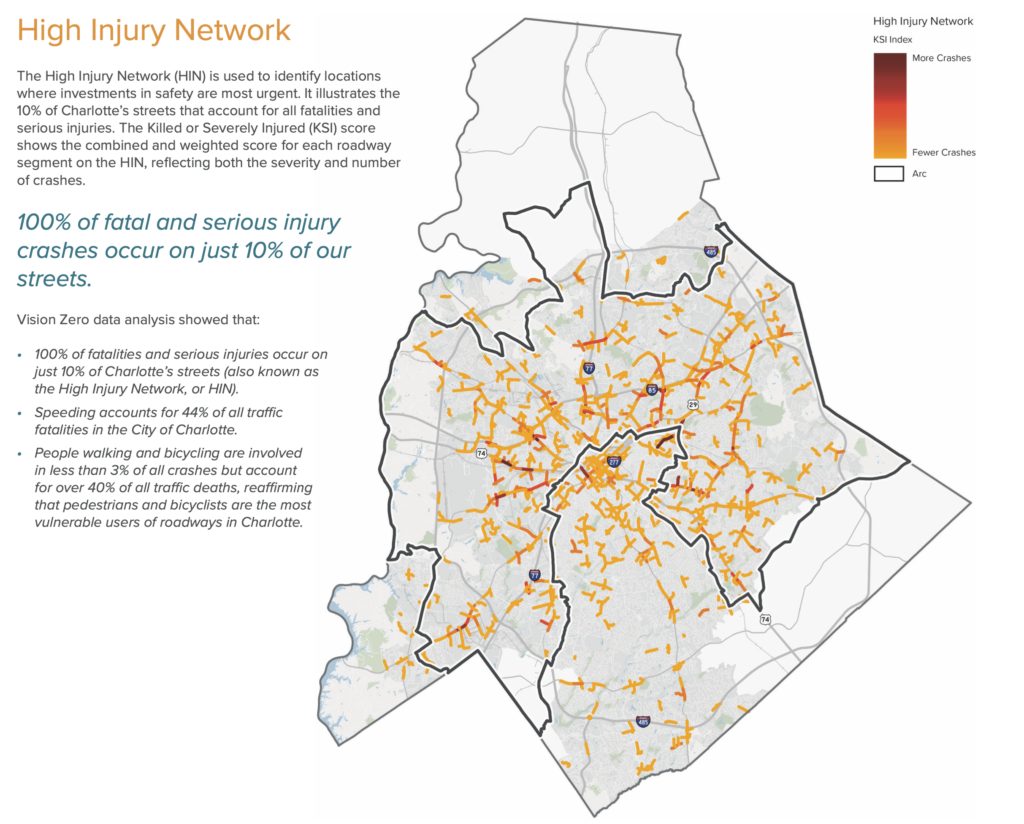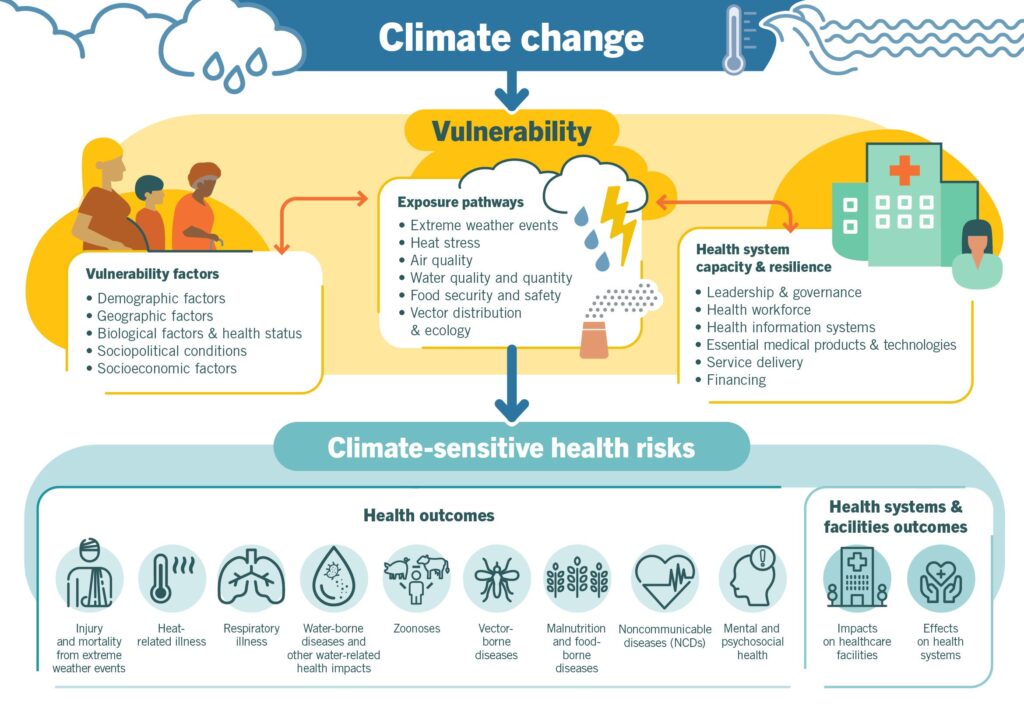Charlotte’s Strategic Mobility Plan could make the city more equitable. Here’s how

This is part 3 in a series highlighting how the Strategic Mobility Plan could benefit Charlotte’s three E’s: the environment, equity, and economy. In this post, we’ll be covering how the plan could help Charlotte grow more equitably, helping residents commute safely and reliably without a car and increasing access to critical economic and health opportunities.
The plan is designed to improve Charlotte’s public transportation system and make the city safer to navigate for people who walk, bike, and ride transit. It also sets an ambitious 50-50 mode share goal — that aims to reduce the share of people driving to work alone — and commits to Vision Zero, the elimination of traffic deaths and severe injuries.
Be sure to catch up on the first two parts of this series, which cover how the Strategic Mobility Plan could reduce our greenhouse gas emissionsand protect our air and water quality.
Charlotte residents should be able to navigate the city without a car
Charlotte is a highly car-dependent city, with most trips made by people alone in their cars. And to get to their destinations, Charlotteans have some of the longest commutes in the state, with almost 40% of residents driving more than 30 minutes to work.
To be able to reach employment, shopping, education, and health care across the city, it’s essential to have a car unless you live in a neighborhood where these destinations are close. But what if, like those in 13,000 other households in Charlotte, you don’t have access to one? Suddenly, meeting your daily needs becomes a lot more complicated.
As of right now, many households do not have safe or reliable access to other methods of transportation. Depending on your destination, taking public transit could lengthen your commute up to 90 minutes — or even longer if there’s a service delay. Delayed service could make you late to work, potentially costing you your job. You may not feel safe cycling on a road without a designated bike lane, or the sidewalks in your neighborhood are not connected enough to make walking an option.
There are many reasons someone may not have a car. Vehicle ownership is expensive and can come with unexpected and costly repairs, making it unaffordable for many families. Maybe someone has a medical condition that prevents them from being able to drive, or aging makes them feel less comfortable getting behind the wheel.
Being so reliant on driving prevents Charlotte from becoming a truly equitable city, putting residents without access to a car at a disadvantage. To really promote equity, we have to enhance transportation options, providing effective transit that is fast, reliable, and safe.
Equitable access to public transportation is crucial for economic mobility in charlotte
Car ownership can be expensive. Transportation is often the second largest expense for households after housing costs. Making sure that all people have reliable alternatives to driving can help them save money while also increasing access to employment and economic opportunities.
According to Charlotte-based Leading on Opportunity, most entry-level jobs are in suburban areas where public transportation is limited and often require working late or on weekends when buses are not running as often or at all.

(Page 12 of the Strategic Mobility Plan shows median household income across Mecklenburg County.)
As identified by the Equality of Opportunity Study, commute times are the single strongest factor in the odds of escaping poverty. The relationship between transportation and economic mobility is even stronger than crime, school test scores, or family stability.
But in Mecklenburg County, many low-income households are located in sprawling areas outside uptown that have some of the longest public transportation commutes, requiring one or more bus transfers.
Having access to efficient public transportation plays a significant role in economic mobility, which has been lagging in Charlotte in recent years. A 2020 report by Opportunity Insights found that Mecklenburg County ranked 96th out of the 100 largest counties in the U.S. for economic mobility.
The Strategic Mobility Plan could bring much-needed overhauls to Charlotte’s transit system
Low economic mobility disproportionately affects communities of color, which make up the majority of public transit riders in Charlotte. Black residents make up 32% of Charlotte’s population but account for over 70% of CATS bus and rail riders.
But Charlotte’s transit investments and associated land use investments have not always benefited the communities that need them most, leading to inequitable access to public transportation for low-income communities and communities of color. This can be seen along the length of the Blue Line light rail, which is quickly becoming surrounded by new market-rate apartments, townhomes, and condos. Very little affordable housing is being built within walking distance of the light rail, and much of the naturally occurring affordable housing in this area is being torn down to build market-rate developments.
If fully implemented and coupled with equitable development policies and investments, the Strategic Mobility Plan could bring much-needed improvements to Charlotte’s transportation infrastructure, placing a greater emphasis on equitable growth. Among the changes outlined are an expanded rail and bus network, better-connected sidewalks, and safer bike lanes for people of all ages and abilities.
Charlotte’s transit network would broaden its focus, moving away from the inefficient hub-and-spoke model to mobility hubs across the city. A 2018 structural redesign of the CATS network provided more opportunities for riders to transfer without having to come into uptown, but more needs to be done to improve overall trip times as Charlotte’s population grows and mobility needs change. Reaching a 50-50 mode share would also make Charlotte much less dependent on driving, helping residents meet their daily needs without the financial burden of a car.

The Strategic Mobility Plan makes a commitment to engage communities that have historically lacked investment in more meaningful and ongoing ways. The city would emphasize input from the residents who rely most on transit and prioritize projects that would improve transit access and equity.
Equitable access to transportation is also an important factor in Charlotte’s health
Changing the way Charlotte moves could also have positive impacts on the health of our communities. Having efficient and reliable transportation is essential for helping residents access the health care and support services they need.
Every year, transportation barriers prevent 3.6 million people in the U.S. from obtaining medical care. Inadequate public transportation especially affects residents who do not have access to a car or cannot drive, such as low-income households, older populations, and people with disabilities.
Lack of mobility is especially a concern for older adults who are no longer able to drive themselves. Without access to other forms of transportation, they are more likely to miss medical appointments, shop for food and medicine less, and become socially isolated, which has negative impacts on their physical and mental health. While 90% of older adults want to “age in place,” being unable to navigate car-dependent cities on their own can make doing so much more difficult, pushing them to leave their homes and neighborhoods.
In addition to increasing access to health resources, cities that are walkable, bikeable, and transit-oriented have healthier and more active residents. Being dependent on cars leads to less physical activity, and every additional hour spent in a car per day increases the risk of obesity. According to a Smart Growth America report, long commutes contribute to almost 1 in 4 adults in the United States not being physically active outside of work.
People who live in neighborhoods where there are safe places to walk and bike are more likely to meet physical activity recommendations. Even taking the bus usually involves walking to and from stops, and transit riders get in an average of about 20 extra minutes of walking a day. As an added benefit, active transportation like walking, biking, and skating have a strong positive impact on mental health and social connectivity.
Reducing the number of cars on the road could also make streets safer. In Charlotte, 100% of fatal and serious injury accidents occur on just 10% of streets, many of which are located in the so-called “arc,” an area that includes the north, west, and east sides of the city. Achieving Vision Zero goals and implementing better street design to reduce traffic speeds could lower rates of injuries.

The Strategic Mobility Plan could also help communities most vulnerable to climate change
As we covered in the first two parts of this series, over-reliance on cars can contribute to climate change and air pollution, which disproportionately affect low-income communities and communities of color.
As temperatures continue to rise, more frequent extreme weather events will threaten community health and safety, increasing disease and mortality rates from intense heat waves, storms, and floods.
Neighborhoods near major highways and roadways are often low-income or communities of color. Living near a highway increases exposure to air pollution, which is linked to higher rates of respiratory conditions and cardiovascular disease, as well as childhood asthma.
By reducing transportation emissions, the Strategic Mobility Plan could help Charlotte become a low-carbon city by 2050 and improve overall air quality. These measures could reduce the severity of some of the impacts of climate change and protect the health of all Charlotte residents, especially those in vulnerable communities.

Thanks for reading!
As a nonprofit, community support is essential for us to keep doing what we do — including providing free articles like this. If you found this article helpful, please consider supporting Sustain Charlotte.
Want to stay in the loop? Subscribe to our weekly newsletter and follow us on Instagram, Facebook, and Twitter.
